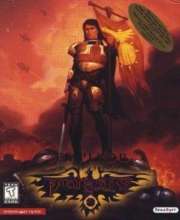Emperor of the Fading Suns
Emperor of the Fading Suns is a video game in the grand strategy genre and with a science fiction setting created by Holistic Design in 1996. This game was based on Holistic's in-house role playing game Fading Suns.[1][2]
| Emperor of the Fading Suns | |
|---|---|
 | |
| Developer(s) | Holistic Design |
| Publisher(s) | SegaSoft |
| Platform(s) | Microsoft Windows |
| Release |
|
| Genre(s) | Turn-based strategy, 4X |
| Mode(s) | Single-player, multiplayer |
The game had a wide array of units and a complex back-story but was rushed to market and released with numerous severe flaws and several features underdeveloped. In patched form, it survives as a popular abandonware title with numerous unofficial, fan-made mods.[3]
Gameplay
The game is played on a galactic map and specific planet maps. Planet maps use a hexa-grid system for movement. Individual units and buildings take up a single grid space. Several menus handle diplomacy, chat, and documentation. In the game, the player controls a feudal lord of a noble house amongst the ruins of a galactic empire. The player must battle other noble houses and rally enough support to be crowned Emperor of the galaxy. The player can start as one of five houses; each has its own advantages and disadvantages. During game setup, the player can customize their house, taking some negative traits such as insanity in exchange for more positive traits, like having all the player's units start out better trained. Each house starts on its respective home planet, and houses starting on temperate planets have an early-game advantage over houses that start on frozen or jungle planets. There are several non-player groups in the game, including the Symbiots, Vau, the Guild, and the Church. In total, there are forty-three planets that can be explored, colonized, and fought over.
Reception
Next Generation rated it four stars out of five, and stated that "With everything from basic combat to diplomatic backstabbing, Emperor of the Fading Suns has a depth of play that is worthy of a classic strategy game."[4] Personal Computer Magazine described the game as "destined to be a classic" in their 1997 review, but also noted that the game suffered from bugs.[5]
Legacy
After the end-of-support by the developer, the fan-community took over the support by creating player-made unofficial patches for the game. These try to fix bugs and/or enhance the game by adding new units and balancing out old ones (modding). For example, the "Hyperion patch" makes it possible for the Symbiots to build additional organic spaceships, so they are not stranded on their home planet if their initial fleet is destroyed.[6][7]
References
- Tringham, Neil Roger (10 September 2014). Science Fiction Video Games. CRC Press. ISBN 148220388X. Retrieved 30 October 2019.
- Software and CD-ROM Reviews on File, Volume 13. Facts on File, Incorporated. 1997. p. 362. Retrieved 30 October 2019.
- Simons, Iain; Newman, James (2004). Difficult Questions about Video Games. Suppose Partners. p. 120. Retrieved 30 October 2019.
- "Stellar". Next Generation. No. 32. Imagine Media. August 1997. p. 122.
- "Personal Computer Magazine". Personal Computer Magazine. 1997. p. 360. Retrieved 30 October 2019.
- Hyperion patch on twarriors.com
- Nova patch
External links
- Official Webpage (archived in 1998)
- Official SegaSoft Webpage (archived in 1997)
- Emperor of the Fading Suns at MobyGames